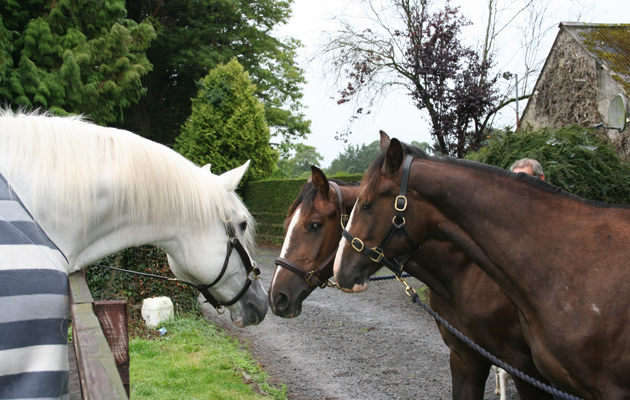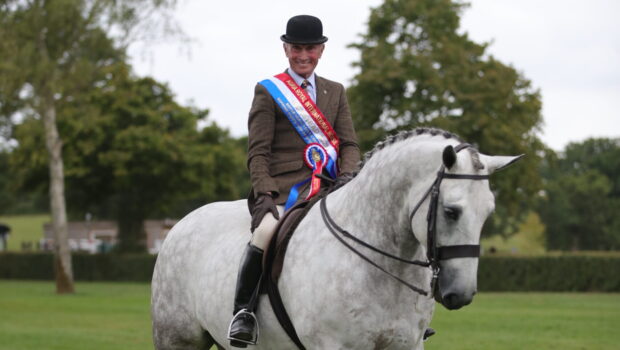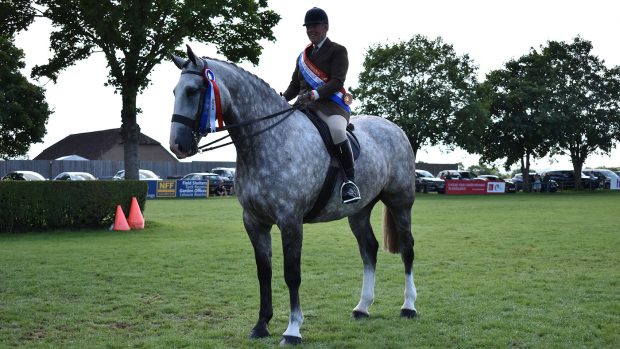The Irish Draught horse originated in 18th century Ireland, when Irish farmers could only afford to keep a single horse on a small tract of land. They required an animal sturdy enough to pull a plough, athletic and bold enough to go foxhunting and jump anything, and sensible, but flashy enough to pull the family trap to church on Sunday.
The foundation stock was the now-extinct Irish Hobby horse, described as brave and agile, a warhorse so effective that King Edward I tried to prevent Irish exports of horses to Scotland during the Wars of Independence between 1296 and 1357. These were crossed with Iberian horses captured from the Spanish Armada shipwrecks on Ireland’s west coast, as well as Anglo-Norman warhorses. Then in the late 19th and early 20th centuries, thoroughbred and Clydesdale blood was introduced to create a taller horse, but one with stamina and refinement.
The Irish government started recording pedigrees of Irish Draughts in 1907 and opened an official studbook in 1917, but these records, held in the Four Courts in Dublin, were lost when the building was set on fire during the Irish Civil War in 1922. Before the Civil War destroyed the records, the First World War had decimated the breed — due to their strength, soundness, and willing temperament, thousands of Irish Draughts went to the battlefields of France and Belgium and never returned. The mechanisation of agriculture following WWI didn’t help them recover their numbers either, as there wasn’t much need for horses to work the land any more, and many of the horses who survived the war were shipped abroad or to slaughter.
During the 1970s, efforts began in earnest to preserve the breed, with the foundation of the Irish Draught Horse Society in 1976 and an offshoot branch in the UK in 1979. The Irish Horse Board, part of Ireland’s Department of Agriculture, oversaw breeding (in 2008, this became Horse Sport Ireland) and since 1983, has maintained the studbook. Breed societies were later founded in the United States and Canada as more equestrians discovered that the intelligent, sensible Irish Draught was the ideal leisure and performance horse. The mounted police in the UK and Ireland use numerous Irish Draughts to this day, as they are obedient and calm enough to cope with confrontational situations.
When crossed with thoroughbreds or warmbloods, the animals produce a sport horse that excels at the highest levels of eventing and showjumping. This has been a double-edged sword: while Irish Draught lines remain popular with sport horse breeders, only 600 pure Irish Draught foals are being registered in Ireland annually, and mares aren’t producing replacements for themselves in the herd. The breed is classified as “endangered but maintained” by the UN. In an effort to preserve the traditional breed and improve genetic diversity, Horse Sport Ireland has introduced inspections of stallions and mares, grading horses on a 1-4 scale. There is, however, a great deal of debate among breeders and breed societies over the best way to ensure the survival these horses.
On the other hand, the high-achieving progeny of Irish Draught stallions in showjumping and eventing has made those bloodlines desirable and the stallions prominent on the international circuits. These include King of Diamonds, who was 21st in the world breeding rankings between 1999 and 2001, the sire of successful showjumpers like Rodrigo Pessoa’s Special Envoy, Joe Fargis’ Mill Pearl, and John Ledingham’s Millstreet Ruby. They also include Sea Crest, a 1979 stallion who had 25 daughters and sons competing at the international level in eventing and showjumping. One of his offspring was Cruising (pictured top with two of his clones), out of an Irish Sports Horse mare, who won numerous grand prix showjumping competitions and went on to become a significant sire himself.
The pure Irish Draught is an athletic enough animal for riders who want straightforward hunter, eventer, jumper, or dressage horse, and a fantastic companion. There is a reason the police use them.
Janet George, a Kidderminster breeder, who has bred Irish Draughts for 15 years, told Horse & Hound: “[They are] not as fast as the thoroughbred, have a lot more brain than most warmbloods, and are ready to learn and keep learning. Any problems you find with an Irish Draught is nearly always due to early handling/experiences — and can nearly always be sorted. They have bone and can carry more weight than a thoroughbred or warmblood, and are much more suitable for the older or more nervous riders. They are mostly all good jumpers to at least 3’6”, but they don’t possess much speed. If I wanted an eventer now, it would be an Irish Draught crossed with a thoroughbred. They make fantastic hunters or happy hackers. And with the right training and a good rider, they would compete successfully at dressage to at least advanced medium.”
Article continues below…
You might also be interested in:

Subscribe to Horse & Hound magazine today – and enjoy unlimited website access all year round
The Irish Draught breed standard describes: “a versatile, powerful and athletic animal with substance and quality. It has a pleasant head, good bone and a short shin, good spring of rib, strong loins and hindquarters and an active powerful stride.” They ideally should be between 15.2hh and 16.3hh, with nine to 10 inches of strong, clean, flat bone. Though they are solid horses, their appearance should not be coarse, and their faces should be intelligent and friendly.
The breed is largely free of health problems, even though inbreeding is a concern due to the popularity of a limited number of bloodlines. However, like many of the horses native to the British Isles, Irish Draughts are ‘good-doers’ and thrive on rough grazing. If fed too rich a diet, they are prone to laminitis and other obesity-related health issues.
For all the latest equestrian news and reports, don’t miss Horse & Hound magazine out every Thursday




